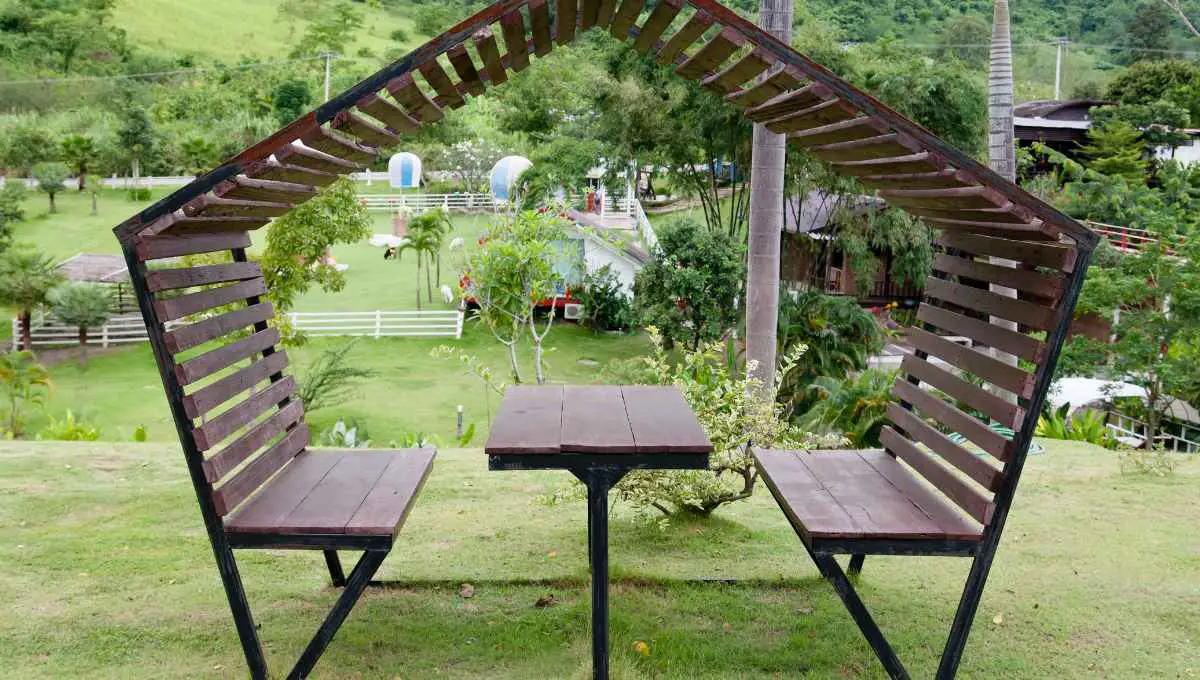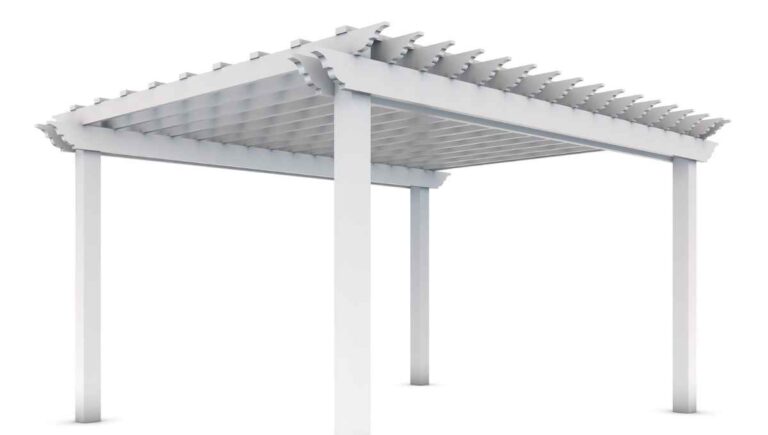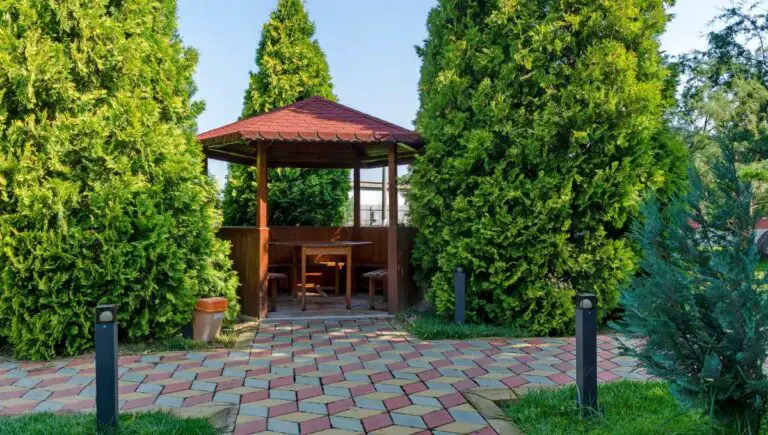Can a Gazebo Be Put on Grass? (Picking the Right Foundation)

A gazebo can be a great addition to any yard. Unfortunately, if you don’t place your gazebo on the right foundation, you may be in for trouble later on. So, can a gazebo be put on grass? If not, what should you use?
It is safe to build your gazebo on grass. However, it’s not the sturdiest of foundations, so if you’re planning on leaving your gazebo up year-round or if it’s a permanent structure, you may want to consider using a firmer foundation.
There are many things to consider when it comes to building a new gazebo, and we’re going to talk about them! To start, let’s chat about when building on grass is okay and when you should avoid it.
This post contains affiliate links from Amazon and other stores. This means Yard Blogger may earn a commission if you make a purchase using any of our links. Please refer to our full affiliate disclosure policy for full details.
Here’s a Quick Pro Tip!
If you’re going to be building a gazebo, you need to have the proper tools and anchors to be able to do the job properly. Plus, using a gazebo build kit can make life exponentially easier.
Here are three options we think are vital to ensuring that your gazebo is installed and anchored the best it can be:
1. Purple Leaf Permanent Hardtop Gazebo – Easily build the permanent gazebo of your dreams with this easy-to-install kit!
2. Earth Ground Anchor – These 18-inch spiral blade anchors can secure everything from a gazebo to a treehouse, so you don’t have to worry about your gazebo in high-wind situations!
3. Antsky Four-By-Four Four-Way Corner Brackets for Gazebo – Ensure that your gazebo is braced and safe for use year-round with these easy-to-install brackets! Includes all necessary hardware for installation!
Building on Grass
If you are building a temporary gazebo that will be taken down when the weather turns cold, there’s really no downside to building it directly on the grass in your yard. You can always purchase extra ground anchors if it doesn’t seem stable enough.
However, if you are planning on building a permanent structure, you may want to consider a more stable foundation, like concrete with rebar. Having this strong foundation can help secure the gazebo to withstand high winds and winter storms.
Additionally, if you plan to use your gazebo year-round, having a good foundation can allow you to store heavier objects in it over winter or to keep lawn chairs and other summer equipment safe.
Can You Put a Gazebo on Artificial Grass?
You can also put your gazebo on artificial grass if you so desire. This way, you get the look and feel of grass without worrying about maintaining it. It’s way easier than trying to mow it, that’s for sure!
Artificial grass also has its drawbacks, however. Artificial grass is mostly made from old tires and can contain various chemicals and metals that are not good for you. Plus, taking away the actual grass in favor of artificial means less usable grass for animals, including worms and bees.
How Do I Install a Gazebo In My Yard?
If you plan to install a gazebo directly on the grass in your yard, you can do so. However, most would then plan on installing a wooden floor for the gazebo to rest on.
This provides something to anchor the gazebo to, as well as adding a flat surface for comfort and to keep anything inside the gazebo from resting on the ground.
Installing a gazebo typically takes a day or two, depending on the type and quality of the gazebo. If you’re adding a pop-up, tent-style gazebo, it can sometimes be put up in five to ten minutes.
You might also enjoy our post on Are Gazebos Covered by Insurance?
However, a metal or wood gazebo of a more permanent nature takes considerably longer, even if it comes from a kit. Here’s a step-by-step method to install a permanent gazebo.
- Level the ground – You need to level the ground where you want the gazebo to sit. You’ll want to give the gazebo a flat surface to be built on, but have the lawn gently slope down after to ensure proper water runoff. If you’re going to be building a deck or flooring for the gazebo, consider digging down a few inches to keep everything level.
- Install the posts of the gazebo – You can either anchor them in concrete in the ground or use stakes or other kinds of anchors. If you bought a kit, it should come with stakes or stabilizers. If not, you can buy braces or stakes yourself. Posts should rest at least three inches below the ground, though they can go at least six if necessary. If you are building a floor, this is also when you’ll want to put down a weed barrier.
- Build your wooden flooring – You can either buy four-by-four beams and hammer them onto support beams placed on the ground, or you can check with your local hardware store to see if they have prefabricated flooring that you can just anchor into place.
- Pour the concrete – If you use concrete instead of wood, it’s time to pour! Once the concrete has set, you can drill your gazebo into place. You will need a hammer drill, a hammer, and brackets. It’s important to note, however, that if you do anchor your gazebo by drilling it into the concrete and then decide to take it apart later on, you’ll be left with holes in your concrete. So, if you plan to add the gazebo to a patio or other open area, you may want to use a different method for future aesthetics. Up to you!
- Position your gazebo – Place your gazebo where you want it to stay permanently, then use the hammer drill to drill holes in the concrete where you’ll be placing the screws for your brackets. Then, use a vacuum to clean out the holes you just made. If you skip cleaning them, the screws won’t fasten correctly, and your gazebo will not be sturdy, so don’t skip this!
- Position the anchor – Place the anchor into the hole you just made, and use your hammer to ensure it’s in place. Then, place the nut on the end and tighten it with your fingers and a wrench to ensure it’s tight. And now, you’ve got a gazebo!
Preparing the Ground
You can place your gazebo on the grass of your yard, but it is still important to prepare the ground, even if the gazebo isn’t permanent. So the first thing you want to do is make sure that you have a flat, level space for the gazebo.
Once you’ve ensured you have a flat area for the gazebo, check out the surrounding ground. Ideally, the ground will slope down from the gazebo, meaning the gazebo will be slightly higher than the surrounding yard.
To ensure this happens, you may have to pile a bit of dirt onto the section where you will eventually want your gazebo to go. Having a higher elevation for your gazebo ensures that the rain won’t pool underneath it when it rains.
Then, you’ll want to check the ground where you plan on placing the gazebo. Make sure that there are no large rocks, tree roots, or other large roots that may inhibit the anchors from being secure when placed.
You don’t want to put your gazebo on uneven ground because the anchors cannot hold as well. Also, having a poorly anchored gazebo means that if you have strong winds or rain, the gazebo is more likely to break or come loose from its anchoring.
Covering the Bases, the Base Options, That Is
If you’ve decided that just placing your gazebo on grass isn’t the best option for you, then you need to know what else you can do. The most common and best bases for a gazebo are either concrete or patio stones.
Now, when you hear concrete slab, you may start to worry. Concrete is messy, and it can cause lots of headaches if not done correctly. But don’t fret; it’s pretty easy to place a concrete foundation under your gazebo.
Here’s a step by step instruction on how to lay concrete for a gazebo:
- Make the frame – You’ll want to use two-by-fours, or four-by-fours, to make a frame that outlines the size of the final concrete slab. It should be at least as long and wide as the gazebo.
- Dig under the frame – Once the frame has been placed, dig out underneath it. You want about six inches of free space under the frame, so you have room for the aggregate and concrete to lay.
- Adding materials – Add about four inches of gravel, crushed rocks, or the aggregate of your choice. Adding an aggregate helps ensure that the gazebo area doesn’t hold water and helps keep it secure.
- Mix or prepare your concrete – If you’re using a quick mix, this step just involves adding water. However, if you use concrete often, you might want to get yourself a concrete mixer to make this step easier.
- Pour the concrete – Take your prepared concrete and pour it evenly onto the gravel. You want the layer of concrete to be at least two inches thick. Make sure to smooth out the concrete carefully so you end up with a level slab once it dries.
- Allow the concrete time to dry completely – Concrete usually takes at least a week to dry, sometimes up to ten days. It’s important you do not attempt to drill into or place things onto the concrete until it’s completely dry, lest you damage your new concrete. Once it’s completely dry, you can install and anchor your new gazebo!
You might also enjoy our post on Do Gazebos Protect From The Sun?
Anchoring the Gazebo
You should always anchor a gazebo to ensure that it will not fall apart in poor weather conditions. Whether you’ve used pavers, a concrete foundation, or are just using cords to anchor your gazebo, it all counts as anchoring. Without these, your gazebo is dangerous.
If you’re placing your gazebo on grass, you can anchor them using guy wires or tent stakes. If you bought a gazebo kit, it should come with anchors, which takes the guesswork out of it for you.
However, if you have decided not to place your gazebo directly on the ground, you’ll need to anchor the gazebo into the concrete or on the pavers you installed first for a foundation. You can then bolt down the gazebo to ensure it stays where it belongs.
If you don’t want your gazebo to be placed permanently on the concrete, you do have another option. You can use weights or sandbags to hold your gazebo in place for as long as you want. Then you’ll just need to remove the weight before taking the gazebo down for the season.
Plans and Permits
Oftentimes, whether or not you need planning permission to build a gazebo comes down to the size of the gazebo to be, as well as where you live and where you plan on placing the gazebo.
If your gazebo is going to be a permanent structure, it will typically need a permit. However, in some states, you only need a permit to build a structure that’s over 100 feet. Additionally, if you’re building a gazebo from a kit, they can have different rules than if you build it yourself.
If you have a landscaper or architect build the gazebo for you, they will also be able to tell you what permits you need to ensure that your new gazebo is legal. Remember, if you don’t get all the necessary permits, you may have to dismantle your gazebo when it’s found to be structurally unsound or illegal.
When in doubt, it’s best to double-check. You can always check your local township or county’s website for local laws regulating out-buildings. If that doesn’t work, you can also contact your city’s planning office for guidance if in doubt.
You might also enjoy our post on Are Gazebos Safe In Wind
Final Thoughts
Adding a gazebo to your yard can really liven it up, and it doesn’t have to be a hard process. If your gazebo isn’t going to stay up all year, you can keep your grass as is and just tie down the gazebo where you want.
If you’re planning on building a permanent gazebo, get the proper permits and consider what kind of foundation you want the gazebo on. Remember, not adding a foundation and just laying a gazebo on grass lowers the gazebo’s structural integrity.
If you’re not going to build a foundation, take the time to prepare the ground properly before you build. That way, your gazebo will last all season and hopefully longer!











